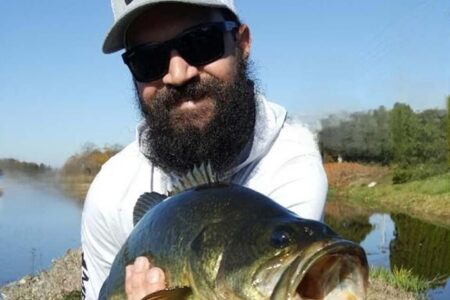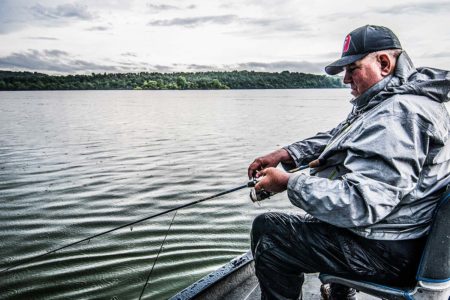
Targeting LI largies with nothing but a topwater approach.
There is nothing more thrilling while fishing – freshwater or saltwater – then a topwater explosion of a fish crashing a plug. Have you ever worked a topwater close to a lily pad edge in the early a.m.? Everything is quiet, the waters are calm and birds are just beginning to sing. You methodically move the Berkley J-Walker with its back and forth slosh, then it happens. The waters first begin to slightly swirl as the bass inspects its early morning breakfast, and then within seconds the water erupts and the bass is hooked. The quiet of the morning has been broken.
On Long Island, with our lakes inundated with all types of cover and ambush areas from grass lines, lily pads, points and submerged timber, topwater bass fishing can be an absolute blast.

The Bomb
I have always felt that the best topwater action was when you surprise a bass in its lair or cover, without disturbing the surroundings. The key to this is super long casts. I feel if you make those long casts, and pinpoint them to the best location, the bass will only be thinking of one thing – it’s dinner time.
To make long casts, especially with a baitcasting rod, which is my favorite for throwing larger Zara Spook and Berkley J-Walker baits, the longer the rod the better. For shore action, depending on cover I’ll use a 7-foot to 7-foot, 3-inch rod. For fishing from my boat, I will always go to the 7-foot, 6-inch rod. Both rods need a fairly fast taper, and be rated for 10 to 20-pound test. For long Island, I always use 20 to 30-pound test Power Pro braid with a 10-foot length of 15 to 20-pound test Ande clear monofilament. I have been using Ande mono for a lot of applications, and for over 45 years. The mono floats and I am not worried about a bass being line shy in any event. Tie the mono to braid using an Albright Knot as this works better than a double Uni-Knot on the heavier mono.
For the smaller poppers and Jitterbugs, or the Heddon Dying Flutter (if you can find one) I opt for a spinning rod. For these lures I try and stay into open water as opposed to lily pad fields. I use lighter 10 to15-pound braid and 10 to 15-pound mono so I can achieve optimal casting distance with the lighter lures.
Work the Edges, Lilies and Structure
One of the best areas to look for bass is any edge of a grass line. In Montauk for example, the south side of Fort is lined with cattails, and offers various points. The Massapequa Chain of lakes offers a lot of lily pad coverage. Working the edges of these fields or right smack in the middle (where there is space) is a good location. Another key component is to practice becoming an accurate caster and have faith you can put the topwater right where you want it; like a 5-foot diameter hole in the pads. An advantage of using heavier braid in the 20 to 30-pound test range is that if you do make an off target cast you will be able to get it out of those weeds quicker and try again on your next cast. The last area I look for is any blown-down trees or underwater sunken logs. Bass will hang under these areas for shelter from the sun’s heat, and lie in wait. A cast made past the structure, and then worked back as tight to the structure as possible is a surefire way to get an explosion.

The Cadence
Cadence is critical when using topwater lures – it must look appetizing or aggravating to a bass. I have seen countless anglers just cast poppers, then make the proverbial reel it fast, pop, reel it fast, pop retrieve with no idea how unjust or unappealing it is to a bass. Sure, they might get a smack or two, but nothing consistent.
For the “spook” style lures – Zara Spook, Berkley J-Walker etc. the key is very similar to fishing saltwater with a Pencil Popper – the lure must remain in the strike zone. After making a long cast, the key is to get the lure walking back-and-forth while reeling ever so slowly. And, the walk must be deliberate and smooth. Gently pulse your rod tip to get the walk, then work on the retrieve to make it smooth and slow.
Moving to the smaller popper, my personal favorite is the discontinued XCaliper XZ2. If you can’t find any, the Rebel Pop-R or higher end Rico will suffice just fine. The smaller poppers need an entirely different cadence then the “spook” style lures. For these, there are two options I always use. The first is to make your cast, and after the lure lands, do nothing until the rings from the splash disappear. Once they disappear, make a deliberate “pop,” “pause,” “pop,” “pause.” I like this method when fishing an area I know there is a bass – like on or close to a bed. The second method is to make a long cast, preferable to a target – hole in the pads, over submerged structure etc. After the cast, make very deliberate reel, pop, reel, pop, reel, and pop all the way back to shore or the boat.

I use Jitterbugs both day and night, but by far a lot more often at night then by day. The Jitterbug, for some reason, and especially at night, will call in the largest bass on the lake every time out. I can recall countless times when my buddy Rick Holmberg and I fished these after dark and scored with 5-pound plus bass on every outing.
The Jitterbug is the perfect noise maker, albeit it subtle noise, on the surface where topwater lures are concerned. I feel the Jitterbug perfectly emulates a small rodent swimming across the water, which is also why I feel it works best after dark. To work a Jitterbug, make your cast, then begin a slow but steady retrieve. If you listen, you will hear the cupping sound of the large blade sloshing back and forth on the retrieve. You want this retrieve to be slow enough to slosh smoothly.
The last is the Heddon Dying Flutter. Before we get into working this gem, there are other options that will work well if you cannot get your hands on the flutter. The Rapala X-Rap, Berkley Spin Rocket or Heddon Wounded Zara Spook are all great lures.
What makes these lures great is their ability to be worked in a variety of options. The lure is a great search bait in my opinion. And, unlike the other lures, this one has a herky-jerky style that may be just enough to really aggravate and entice a bass to explode on it. For this lure you can make a cast and give solid jerks to the rod tip to make it really move water. You can also slow it down and make slight twitches if you know or can see a bass following but not attacking.

Feather or Not?
There is one last item to be covered when fishing topwater lures for bass – feathers. There are arguments on both sides of the fence regarding feathers on the tail hook of topwater baits. Some feel they are not needed, while others, myself included, feel they can make a difference on certain days or type of topwater.
I feel on the smaller XCaliper or Rebel style poppers, the tail hook with feather will entice more strikes. Something about the feather wavering in the water when you pause must look like a wounded or fluttering baitfish. On the other hand, the larger Zara Spook, Berkley J-Walker and Whopper Plopper style baits I feel the tail feather will decrease their action. As you move down to the smaller 3-1/2 inch to 5-inch spook style, the feather makes a difference. I remember fishing a tournament where I could not get a touch on my favorite frog colored Zara Spook. Once I added the tail feather, it was non-stop action, and in fact the tournament win produced an all-expense paid trip to El Salto Mexico! If you have doubts, change it up until the fish tell you what they want, then have a bang up day on surface explosions.



